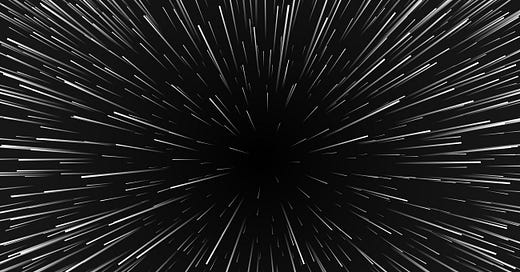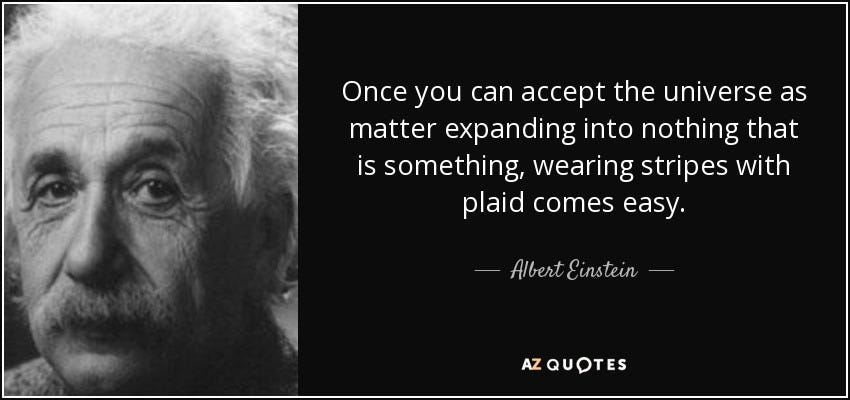(#9) A Universe that is disappearing faster than the speed of light
An expanding universe going farther away from us
Is Universe finite or Infinite
For thousands of years, physicists, philosophers and astronomers grappled with questions about the size and age of the universe. Is the universe infinite or does it have an edge somewhere?
You would wonder - the universe had to be either finite or infinite, but both of these alternatives presented problems.
Lets assume universe is infinite:
In the early 1800s, German astronomer Heinrich Olbers argued if the Universe was infinite and contained stars throughout then if you looked in any particular direction, your line-of-sight would eventually fall on the surface of a star. Therefore, if the Universe was infinite, the whole surface of the night sky should be as bright as a star. Obviously, there are dark areas in the sky, so the universe must be finite.
Lets assume universe is finite:
If the universe was finite, and you stuck out your hand at the edge, where would your hand go?
Isaac Newton’s laws of gravity clearly states that gravity is always attractive and every object in the universe attracts every other object. If the universe truly was finite, the attractive forces of all the objects in the universe should have caused the entire universe to collapse on itself. This clearly neither happened nor there is any sign of it happening.
When Einstein developed his Theory of General Relativity, he too ran into the same problem that Newton did: his equations said that the universe should be either expanding or collapsing, and yet he assumed that the universe was static. He found it rubbish to have an ever expanding or collapsing universe.
He rather developed a novel idea to counteract this notion - he added a positive cosmological constant to his equations of general relativity to neutralize the attractive effects of gravity. This cosmological constant cancelled the effects of gravity on very large scales, and led to a static universe also termed as Einstein’s static universe
Edwin Hubble looked outside Milky Way Galaxy
In the 1920s, Hubble was among the first to recognize that there is a universe of galaxies beyond the boundaries of our Milky Way.
A truly mind-blowing realization!
Edwin Hubble observed stars in a hazy patch of light that at the time was known as the Andromeda nebula.
Hubble observed variable stars, those that change in brightness.
He measured the period of how long a star took to dim and brighten.
From the period of brightening, he calculated the star’s intrinsic brightness.
From that, he could calculate the distance.
That’s when he realized that the stars in this nebula were so far away that it couldn’t exist within our own galaxy.
This was a revelation. As soon as astronomers learned that spiral nebulae like the one in Andromeda are separate galaxies, the known universe got much bigger.
Hubble expands the idea of Universe
But was this huge universe stationary? Or was it expanding? Or contracting?
The answer involved the light of galaxies as a whole. Astronomers observed shifts toward the red end of the spectrum in distant galaxies’ light. They interpreted this red shift as a sign that the galaxies are moving away from us. Hubble and his colleagues compared the distance estimates to other galaxies’ with their red shifts.
On March 15, 1929 – Hubble published his observation that the farthest galaxies are moving away faster than the closest ones.
After Hubble discovered that the universe was expanding, Einstein called the cosmological constant his "greatest blunder."
A Universe expanding faster than speed of light
The expansion of space is calculated by measuring how light from faraway galaxies stretches as it moves away from Earth, to determine how fast the universe is expanding — a value known as the Hubble constant.
The value for the Hubble constant is nearly 73.2 kilometers per second per megaparsec.
One megaparsec is equivalent to 3.26 million light-years.
It means that if you look at a galaxy 1 megaparsec away, it will appear to be receding away from us at 73.2 km/s.
If you look at a galaxy 2 megaparsec away, it recedes at 146.4 km/s.
Three megaparsec away? You get it - 219.6 km/s.
And on and on: for every megaparsec, you can add 73.2 km/s to the velocity of the far-away galaxy.
So it's easy enough to compute: At some point, at some distance, the speed tips over the scales and exceeds the speed of light, all from the natural, regular expansion of space.
It means that any object beyond about 4.5 Gigaparsecs (or 14-to-15 billion light years) will never be reachable by us, or anything we do, from this point forward. All of those objects — objects making up 97% of the observable Universe by volume — are all presently beyond our reach.
A Universe that is disappearing at the speed of light
As time goes on, all the objects that are caught up in the expansion of the Universe will accelerate away from us, faster and faster. Let enough time go by, and all of them will eventually wind up receding faster than the speed of light, unreachable by us in principle, no matter how fast of a rocket we build or how many signals we launch at the speed of light itself.
The Universe we have today is disappearing thanks to the accelerated expansion of space. Although no object ever moves through the fabric of space itself faster than the speed of light, there is no speed limit on the expansion of the fabric itself.
How can expansion of Universe break through the light speed barrier?
Just like raisins in a leavening loaf of raisin bread dough, every galaxy in the Universe see all the other galaxies moving away from them, with the more distant raisins (or galaxies) appearing to move away at faster rates.
It isn't because the raisins are moving relative to the dough that they're embedded in. Rather, it's owing to the fact that the dough itself — just like the fabric of space itself — is expanding, and the raisins (or galaxies) are just along for the ride.
![The 'raisin bread' model of the expanding Universe, where relative distances increase as the space... [+] (dough) expands. The farther away any two raisin are from one another, the greater the observed redshift will be by time the light is received. The redshift-distance relation predicted by the expanding Universe is borne out in observations, and has been consistent with what's been known all the way back since the 1920s. The 'raisin bread' model of the expanding Universe, where relative distances increase as the space... [+] (dough) expands. The farther away any two raisin are from one another, the greater the observed redshift will be by time the light is received. The redshift-distance relation predicted by the expanding Universe is borne out in observations, and has been consistent with what's been known all the way back since the 1920s.](https://substackcdn.com/image/fetch/$s_!BvND!,w_1456,c_limit,f_auto,q_auto:good,fl_lossy/https%3A%2F%2Fbucketeer-e05bbc84-baa3-437e-9518-adb32be77984.s3.amazonaws.com%2Fpublic%2Fimages%2Fe5eee028-86d9-4f0d-ab19-dcebad075870_735x625.gif)
The restriction that "nothing can move faster than light" only applies to the motion of objects through space. The rate at which space itself expands — this speed-per-unit-distance — has no physical bounds on its upper limit.
https://earthsky.org/space/this-date-in-science-edwin-hubble-and-the-expanding-universe/
https://skyserver.sdss.org/dr1/en/astro/universe/universe.asp
https://www.space.com/33306-how-does-the-universe-expand-faster-than-light.html
https://www.forbes.com/sites/startswithabang/2016/06/10/can-the-universe-expand-faster-than-the-speed-of-light/?sh=1bf004783605
https://en.wikipedia.org/wiki/Static_universe#cite_note-2
https://www.forbes.com/sites/startswithabang/2020/06/12/ask-ethan-how-does-the-fabric-of-spacetime-expand-faster-than-the-speed-of-light/?sh=3872a0153b5f







